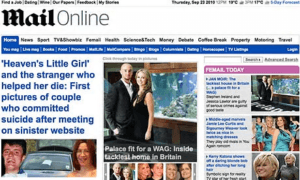Daily Mail: Hailing Hitler to revealing how you too can get Mark Wahlberg’s Pecs

There is no one Daily Mail. While the daily newspaper is more likely to focus on the ills of immigration, the website, at the time of writing, heralded such stories as Khloe Kardashian’s struggles with her body image (real quote), Hillary Duff’s $11k Hermes purse (which she used while running errands in Studio City!), Elsa Pataky’s sultry lingerie and Natash Oakley’s natural cuves in bikinis (in candid beach snaps!).[1]
And yet, while completely dissimilar, each support the others’ popularity and work in tandem to ensure the group remains incredibly popular and profitable, [2] with the website the biggest English-language newspaper in the world with 229 million monthly global unique browsers.[3] If other print publications needed it, here is proof that newspapers can use the digitalization of its industry to its advantage and create not simply a necessary supplement to their offline media.
The Mail online was launched in 2004.[4] Like many of its UK peers, it was initially simply an online portal for what it published on paper. However, with an audience of 45 to 65 plus,[5] it was clear that “it [was] not the easiest job in the world to get the older audience online”.
However, in 2008, it was relaunched with its own Mail Online brand and the [in]famous sidebar of shame. Creating its own content allowed it to create new value that the print edition could not – appealing to workers on coffee breaks, engaging people during their lunch, and ensuring that once you clicked on one article you were engulfed by many others. In fact this is not the same newspaper, with its ‘xenophobia and parochialism’[6] that so many people in the UK find abhorrent.[7]
There are two key business operational decisions that has allowed for growth of 38% pa since the relaunch.[8] With the increasing use of multiple stimuli and many screens, a Microsoft study has found that the human attention span is at an all-time low.[9] The Mail Online plays into the trend of ‘clickbait’.[10] And it does so with large images, naked men and women, and bold headlines.
Yet, given its link to the Daily Mail, this is no simple ‘clickbait’ that you see elsewhere online, it has the rubber stamp of Middle England’s go-to news resource.[11] Maintaining a safe enough distance to be apolitical and ensure no reader group is marginalised,[12] but enough to be more respectable than much of the spam across the rest of the web.
The value of the website is that it creates a new audience, while allowing the old audience – predominantly women of the AB and C1 class[13] – to engage with the paper throughout the day. And contrary to what is seen with many of the news items from myriad sources that come up on facebook, the Mail Online, is Uber-like in its ability to draw readers to its pages first before looking elsewhere.
With its popularity in the UK, it has also expanded this format to the US. And with its long front page and “hectic” number of articles, it scores highly in google searches.[14]
There are improvements to be made – although revenue from advertising continues to grow, its revenue[15] is just 18% of the print paper and just 5p per user. [16] Although it may seem hard to monetize these online platforms,[17] Facebook was confronted with a similar dilemma.
And here is where the dilemma lies.
A paywall is out of the question given the effect that this will have on those who read it and are used to having their articles for free. So is more intrusive advertising. However, the expansion of paid for ads for clothes as well as a Facebook style use of user data to target users more effectively with the ads they are receiving.
The Daily Mail newspaper is “an example of how to age as ungracefully as possible”. Seen by many in the UK as racist,[18] homophobic,[19] it has begotten a wildly successful website that mixes gossip with lifestyle. The issue now is how to monetize the opportunity that is has created while ensuring the loyalty of its customer base.
[1] www.dailymail.com
[2] http://www.dmgt.com/~/media/Files/D/DMGT/reports-and-presentations/100-51081.pdf
[3] http://www.mailadvertising.co.uk/mail-online
[4] https://www.theguardian.com/media/2014/may/15/mail-online-10th-birthday-sidebar
[5] http://www.campaignlive.co.uk/article/515713/daily-mail-may-difficulty-reaching-target-audience-online?src_site=mediaweek
[6] http://www.slate.com/articles/business/moneybox/2012/02/daily_mail_new_york_times_how_the_british_tabloid_became_the_world_s_most_popular_online_newspaper_.html
[7] https://www.theguardian.com/media/2013/oct/03/daily-mail-ralph-miliband-francis-maude
[8] http://www.dmgt.com/~/media/Files/D/DMGT/reports-and-presentations/100-650.pdf
[9] http://time.com/3858309/attention-spans-goldfish/
[10] https://www.wired.com/2015/12/psychology-of-clickbait/
[12] http://www.slate.com/articles/business/moneybox/2012/02/daily_mail_new_york_times_how_the_british_tabloid_became_the_world_s_most_popular_online_newspaper_.html
[13] http://www.mailadvertising.co.uk/uploads/files/Homepage.pdf
[14] http://www.newyorker.com/magazine/2012/04/02/mail-supremacy
[15] http://www.dmgt.com/~/media/Files/D/DMGT/reports-and-presentations/100-51081.pdf
[16] http://www.pressgazette.co.uk/mail-online-has-grown-ten-fold-since-its-2008-relaunch-but-is-it-journalism/
[17] https://medium.com/@frank_meehan/dailymail-online-results-even-at-huge-scale-online-news-is-hard-to-monetise-7fd9843fe551#.ukgfcb9o8
[18] https://www.theguardian.com/media/greenslade/2011/dec/06/dailymail-oswald-mosley
[19] https://www.theguardian.com/commentisfree/2009/oct/16/stephen-gately-jan-moir




Of course I clicked on this article for the click-bait title! But what an interesting situation – the Daily Mail actually seems to be much more innovative in terms of taking advantage of the online platform than newspapers such as NYT or WSJ. For these established and well-respected newspapers, the online portals are mostly a re-packaging of the print content (with some additions of videos and multi-media articles). I had not thought about the possibility of actually creating separate content with the belief that people are looking for different things when they engage with an online versus a print newspaper. However, as these two arms diverge (and, perhaps, the print paper starts to fall out of favor), perhaps it may be best for the online paper to be spun out? At the very least, there needs to be some organizational segregation so that there is no conflict of resources between the new/growing division and the original/shrinking division. This reminds me of the JC Penney case, where Ron Johnson actually suggested appointing someone to “wind down” the old JCP. Perhaps the two papers need to be separated so that someone can help the original Daily Mail (gracefully) exit the scene and allow the new Mail Online flourish.
Enjoying your open disdain for this newspaper (if it deserves to be called that). I have for obvious reasons been thinking a lot over the past couple of weeks about the role of increasingly sensationalized (and often outright fake) news that is proliferating online and how it seems to be eroding the quality of public dialogue and political discourse on both sides of the pond. In some ways it feels as if the digital era has spawned a market failure in the news media industry, leading many publications to engage in either a race to the bottom or to see their market share gradually erode. Is there an appropriate policy response to this? Or is it possible for the industry to continue to regulate itself and continue to provide us the appropriate amount of serious journalism alongside cat videos? An optimistic person might point to “millennial” era media outlets like Buzzfeed or Vice, which seem to be attempting to move up the value chain from just clickbait to producing serious (though perhaps more irreverent) journalism as well.
You pointed this out in your article, but it is really interesting that the online version of the Daily Mail seems to have nothing to do with the print version. Most other newspapers, such as the NYTimes, have similar content on their print and online mediums. Perhaps that is why the Daily Mail website has been so successful, since people who read the newspaper will also go online to access totally different content, in addition to drawing in new readers.
A common issue across all newspapers is figuring out how to monetize their websites. I wonder if over time newspapers will be unable to figure out how to monetize without destroying readership, and the industry as a whole will just have to settle with smaller revenues. I think we’re already seeing a bit of this, as newspapers and magazines are doing massive layoffs and bringing in newer, smaller teams of young leaders who are good at digital.
The problems, magazines comparable to Daily Mail are facing, are more serious than the ones, other magazines or even newspapers are facing because of the difference in the target audience.
People, who are reading these kind of news are likely to consume without paying online, so the magazine could lose their audience by installing a paywall, while quality journalism is more likely to be paid by their audience.
Possibilities for these magazines could be to broaden their core product and install components, you have to pay for. After researching their new online audience, they could add features, this audience is interested in. Such a feature could be for example a mobile game in which you can buy items which help you to succeed earlier.
Interesting to learn about how the Daily Mail’s online strategy has evolved over time. As the percentage of readers that “consume” content through online channels increases (vs. print), the question around how to monetize this user base will become more relevant. I found it surprising that you mentioned that a subscription model is “out of the question”. While I agree that making customers pay will deter a number of readers, as long as the content is high quality there should be a user base willing to pay to get access to it. Other publications like The Financial Times, The New York Times and The Economist have opted for this model and been moderately successful (http://aboutus.ft.com/files/2016/03/FT-2015-Results.pdf, http://www.economistgroup.com/results_and_governance/results_at_a_glance.html, http://s1.q4cdn.com/156149269/files/doc_financials/annual/2015/Bookmarked-2015-Annual-Report.pdf). So the question, in my opinion, is how to make sure that the content that the Daily Mail generates online is sufficiently relevant to justify having to pay for it.
Alex, thank you for letting me know that Daily Mail online is not representative of actual news in the UK. While their online articles might not show intellectual depth, someone somewhere in their planning team has done a brilliant job. Digitization allowed them to target a very different audience from their traditional audience and essentially have two different products. They have been part of a sweet spot right now where the readership of the online version and the print version probably does not have too much overlap. This has allowed the newspaper to be so “creative” on the online end and still retain its “beloved” ( racist, homophobic, anti-immigrant…) status in the print version. As the readership ages (and dies), I wonder how the overlap will affect Daily Mail. I am sure they will have to address the issue of having a consistent image across various versions and then we will see if the real Daily Mail shall stand up !?